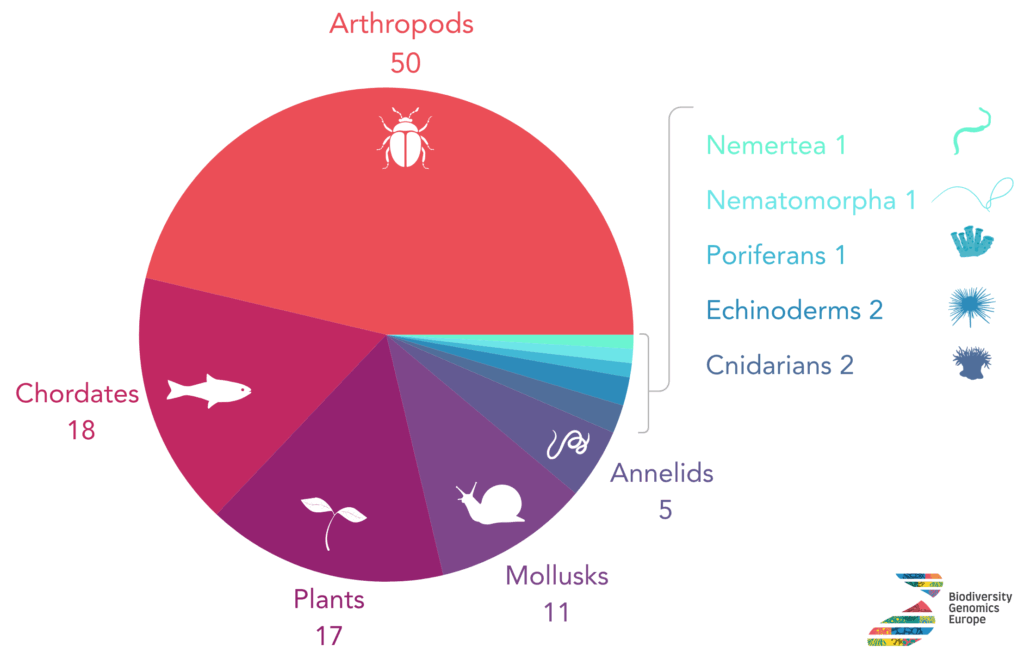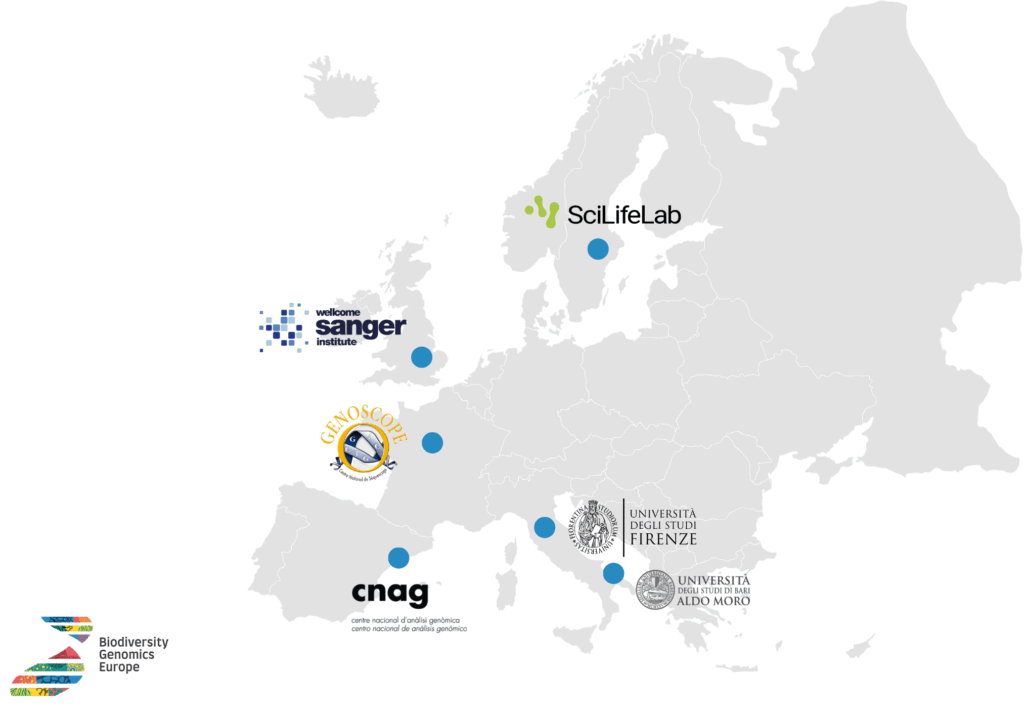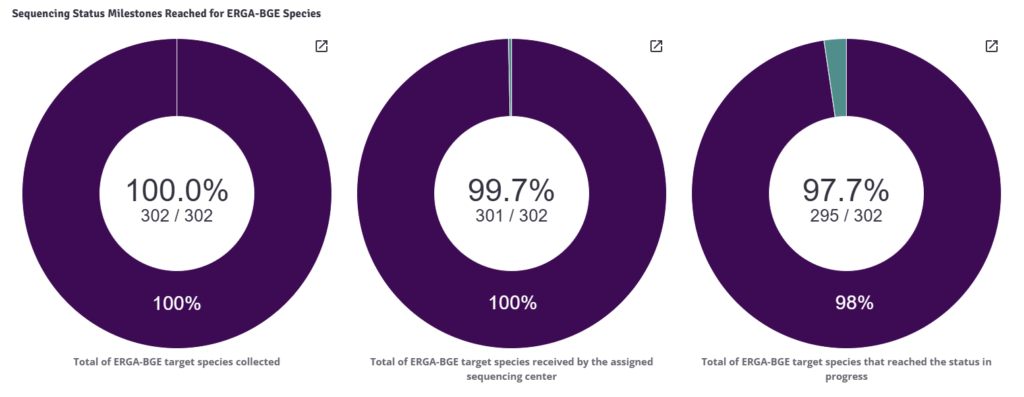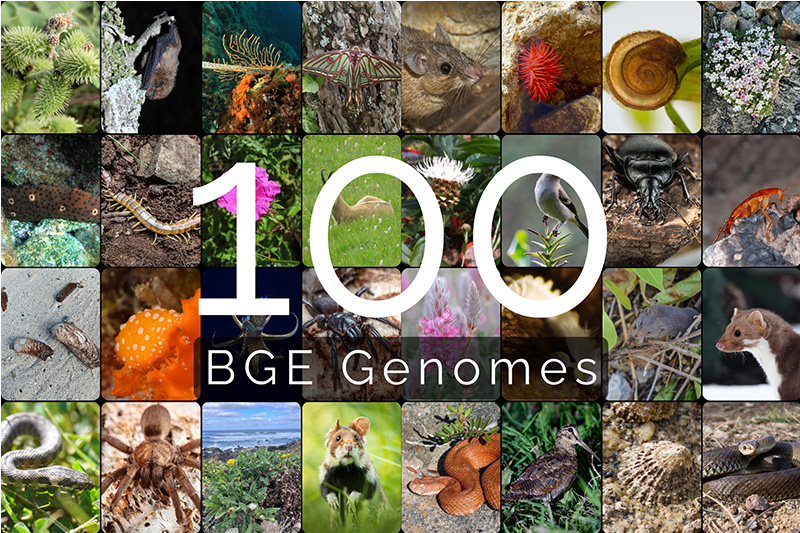27 October 2025
Celebrating 100+ BGE genomes!
By Luisa Schlude Marins
In October 2025, Biodiversity Genomics Europe (BGE) reached a milestone: over one hundred genomes have been sequenced and publicly released as part of the project. More than simply collecting samples and sequencing genomes, BGE demonstrates that it is possible to achieve this in a distributed manner, building capacity and contributing to the development of standardized workflows that can be scaled up across Europe. In this way, BGE plays a key role in supporting the ambitious goals of the European Reference Genome Atlas (ERGA), the regional node in Europe of the Earth BioGenome Project.
While many more BGE genomes are currently on the way – in the process of data generation or computational assembly – the release of the 100th high-quality reference genome marks an important milestone for the project.
Genomes across the tree of life
From its onset, BGE aimed to sequence broadly across the tree of life, allocating resources to sequence groups of species that are often neglected in biodiversity research – the so-called “Dark Taxa”. Species were also prioritized considering their relevance to agriculture, fisheries, key ecosystem processes, as well as endemic, threatened species, pests, and disease vectors.

Taxonomic distribution of the first 108 BGE genomes: representatives of 10 different eukaryotic phyla have already been sequenced! Species sequenced as of October 6th, 2025.
About one third of the BGE genomes released so far are so-called “community genomes”. This means that they were produced with the direct support of the broader community of biodiversity researchers in Europe through open calls promoted by BGE – who had a chance to nominate species for sequencing and – if selected – sample them and author the genome reports that characterize those genomes. Click here to read more about this “community-driven” approach to genome sequencing.
Another third of the genomes were sampled in targeted campaigns in some of Europe’s most important biodiversity hotspots in different areas of Greece, Spain, and Slovenia. These countries are exceptionally rich in biodiversity and so were considered as priority areas where genomic data will help the generation of knowledge about many species that are still poorly known to science.
Finally, some of the genomes sequenced are connected to BGE’s set of Case Studies – applied projects that seek to demonstrate the use of biodiversity genomics in different real-world settings. One of these projects – led by researchers at Estación Biológica de Doñana-CSIC in Seville, Spain – investigates the genomic basis of vectorial capacity and insecticide resistance in Culex mosquitoes using reference genomes and population genomics. The genomes of four Culex species were produced by BGE and analysis is underway – the new knowledge brought by this study will inform authorities and could lead to an impact on genomics-informed public health policies. Click here to learn more about this case study.
Sequencing & Assembling – a continental effort
Following sampling, the subsequent steps of DNA extraction, sequencing and genome assembly are performed by six different sequencing centers distributed across Europe. The “BGE Sequencing network” includes Genoscope, The Centro Nacional de Análisis Genómico CNAG, The Wellcome Sanger Institute’s Tree of Life Programme, SciLifeLab, University of Florence and the University of Bari. These institutions vary in size, infrastructure, and areas of expertise and by bringing them together, the BGE project has enabled valuable exchanges and technical developments that strengthen European capacity for genomic sequencing and research.
 The BGE network of sequencing centers: 6 partner centers distributed across Europe are responsible for producing and assembling the data for a diverse set of species, exchanging protocols and their experiences.
The BGE network of sequencing centers: 6 partner centers distributed across Europe are responsible for producing and assembling the data for a diverse set of species, exchanging protocols and their experiences.
Open genomes – data available to all
All data produced under BGE are made openly available for anyone to use, and the genome assemblies are no exception. All the genomes produced so far – and the ones that will follow – are made available through the European Nucleotide Archive (ENA) – and can be accessed and downloaded by anyone, anywhere in the world. Head to the ERGA Data Portal to browse the data produced by BGE and other ERGA associated initiatives: https://portal.erga-biodiversity.eu/home
To further increase the transparency and reproducibility of the reference resources produced, BGE is also producing Genome Reports: standardized technical publications which describe all the methodological steps taken to produce a reference genome: sampling, sequencing, assembling and annotating. The reports are available in two dedicated collections:
- The “Genome Reports from the Biodiversity Genomics Europe Project” Collection hosted at Open Research Europe, an open access publishing venue for European Commission-funded research.
- The “European Reference Genome Atlas (ERGA) Community Genome Reports” Collection hosted at Pensoft’s RIO Journal, which also serves as an open platform for other ERGA associated genomes, beyond BGE.
Ongoing work and more genomes to come!
Reaching 100 genomes is an important milestone, but it’s not the end. Many more genomes are currently in production, and an increase in the number of releases is expected in the coming months as the BGE project approaches its conclusion. Stay tuned for more updates!

Other important Sequencing Status Milestones Reached for ERGA-BGE Species. Explore the ERGA-BGE page in the Genomes on a Tree platform (https://goat.genomehubs.org/projects/ERGA-BGE) for an overview of all the assemblies being produced by BGE’s genome stream.
🧬 Check the collection of ERGA-BGE genomes at the European Nucleotide Archive
🌍 Check the distribution of all genomes sequenced under the ERGA umbrella
📑 Check the collection of ERGA-BGE Genome Reports already available
Learn more:
- What is a reference genome and what does it mean to sequence it?
- What is the European Reference Genome Atlas?
- How are ERGA and BGE connected?
Photos by
Georgiakakis,P. , Frédéric Zuberer, Trichas,A., Elicio Tapia, Sébastien-Lavergne, Stephan Koblmüller, Alfredo Garcia, Schmidt Ocean Institute, Simon Vasut, Ricardo Jorge Lopes, Miquel Pontes, Helena Bilandžija, Thomas Daftsios, FP Lima, Mina Trikali, Jairo Patiño, Daniel Fernández, Pedro Oromí.




